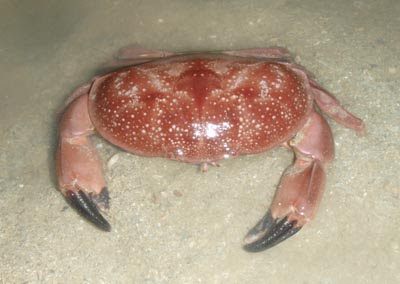
I have yet to find out the id of this spider that I saw last week.



 The name tarantula comes from another species of spider that is found in southern Italy. Tarantulas are not really dangerous to most humans. Minor and occasionally more severe problems do occur with some of them include sensitivity and allergies to it's venom.
The name tarantula comes from another species of spider that is found in southern Italy. Tarantulas are not really dangerous to most humans. Minor and occasionally more severe problems do occur with some of them include sensitivity and allergies to it's venom. 
 Tarantulas are shy creatures, if they are disturbed they will usually run away, either to their burrow or to the nearest cover. Sometimes, the spider will adopt a threat posture by lifting its cephalothorax and spreading its jaws and first two pairs of legs (as in the photo below).
Tarantulas are shy creatures, if they are disturbed they will usually run away, either to their burrow or to the nearest cover. Sometimes, the spider will adopt a threat posture by lifting its cephalothorax and spreading its jaws and first two pairs of legs (as in the photo below).













 At the coral rubble area, we saw this polka dot (Jorunna funebris) nudibranch.
At the coral rubble area, we saw this polka dot (Jorunna funebris) nudibranch. Another green nudibranch (Ceratosoma sinuata) and lots of orange Gymmodoris rublopabulosa nudibranch.
Another green nudibranch (Ceratosoma sinuata) and lots of orange Gymmodoris rublopabulosa nudibranch. We also saw quite a few flatworm (different from a nudibranch, they don't have exposed gills as the nudibranch)
We also saw quite a few flatworm (different from a nudibranch, they don't have exposed gills as the nudibranch) Another flat worm
Another flat worm This is giant clam (Tridacna squamosa) is getting very rare in Singapore.
This is giant clam (Tridacna squamosa) is getting very rare in Singapore. A very beautiful Fann Wong....oops! Is fan worm in white!
A very beautiful Fann Wong....oops! Is fan worm in white! And out of no where, I saw this Arcopora corals in white. Bleaching?
And out of no where, I saw this Arcopora corals in white. Bleaching? And on the list, there are many interesting creatures that we saw... Indeed a very fruitful trip!
And on the list, there are many interesting creatures that we saw... Indeed a very fruitful trip!


 The yellow flower that not more than 1cm in diameter is another carnivorous plants - bladderworts, that can be found here at Tuas. often look like miniature orchids and can have stunning colors and great beauty. Bladderworts have no roots. Their flowers are usually yellow and have two petals which look like lips.
The yellow flower that not more than 1cm in diameter is another carnivorous plants - bladderworts, that can be found here at Tuas. often look like miniature orchids and can have stunning colors and great beauty. Bladderworts have no roots. Their flowers are usually yellow and have two petals which look like lips. This bladderwort lives in shallow water with floating tangle of thin green thread and tiny bladders growing from it. It traps and eats mosquito larvae, miniature worms and other little animals it sucks into its underwater bladder-traps.
This bladderwort lives in shallow water with floating tangle of thin green thread and tiny bladders growing from it. It traps and eats mosquito larvae, miniature worms and other little animals it sucks into its underwater bladder-traps. However, the fate of this beautiful place just like their prey - the end is near! The construction will soon cover the entire area. . .
However, the fate of this beautiful place just like their prey - the end is near! The construction will soon cover the entire area. . .
This sea pandan fruit really looks like a pineapple!

Another creature that rely heavily on camouflage - hairy crabs(Pilumnus vespertilio)
and a Euxanthus exsculptus crab.





Check them out at:
The tide chaser blog & discovery blog.





 Red swimmng crabs
Red swimmng crabs and this juveniles flower crab. I'm not sure why there are so many different patterns on the carapace.
and this juveniles flower crab. I'm not sure why there are so many different patterns on the carapace. We saw this cute cuttle fish
We saw this cute cuttle fish We also witness the magician in actions. It changes it's colour so rapidly to match and blend with the environment!
We also witness the magician in actions. It changes it's colour so rapidly to match and blend with the environment! We also saw quite a lot of slugs such as the Gymmodoris rublopabulosa above.
We also saw quite a lot of slugs such as the Gymmodoris rublopabulosa above. a Phyllidia pustulosa
a Phyllidia pustulosa Polka dot (Jorunna funebris)
Polka dot (Jorunna funebris) Discodoris boholensis
Discodoris boholensis and a Acanthozoon sp. flatworm.
and a Acanthozoon sp. flatworm.
 different colours of feather star. Like other echinoderms, feather stars have radial symmetry with numerous arms project from a central disc. However, the major difference as compare to other sea star is their feedings habot. Feather stars are filter feeders and their mouth is on the upperside rather than bottom as with other sea stars.
different colours of feather star. Like other echinoderms, feather stars have radial symmetry with numerous arms project from a central disc. However, the major difference as compare to other sea star is their feedings habot. Feather stars are filter feeders and their mouth is on the upperside rather than bottom as with other sea stars. This turban shell almost invisible with the colour almost the same with the substrate.
This turban shell almost invisible with the colour almost the same with the substrate.